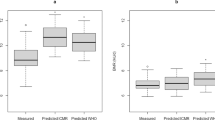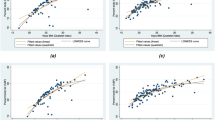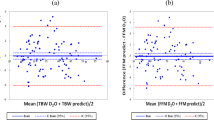Abstract
Objective:
To evaluate the FAO/WHO/UNU equations for predicting resting metabolic rate (RMR) in Vietnamese adults.
Design:
A cross-sectional study with healthy subjects was carried out at the Basic Nutrition Department, National Institute of Nutrition, Vietnam. RMR was measured by indirect calorimetry, and anthropometric indices were recorded. Equations derived by linear regression of RMR vs body weight were compared to the FAO/WHO/UNU 1985 predictive equations.
Subjects:
A total of 188 subjects (98 males and 90 females) had a normal body mass index (BMI) and were divided into four groups by sex and age (male and female subjects 18–29 and 30–60 y old).
Results:
Mean RMR (MJ/kg/day) in males was lightly significant by higher than that in female subjects in the 18–29 y old age group (0.1074±0.0100 vs 0.0965±0.0123) and the same result was seen in the 30–60 y old group (0.1018±0.0114 vs 0.0922±0.0129). However, differences were not statistically significant in the two age groups. Compared to the FAO/WHO/UNU equation, our findings were 7.4, 9.0, 11.7, and 13.5% lower in the four groups, respectively (P<0.001).
Conclusion:
Our findings suggest that the FAO/WHO/UNU equations may overestimate RMR in Vietnamese adults. Further studies examining the relationship between body weight and RMR are needed, and establishing new predictive equations for RMR in Vietnamese should be a priority.
This is a preview of subscription content, access via your institution
Access options
Subscribe to this journal
Receive 12 print issues and online access
$259.00 per year
only $21.58 per issue
Buy this article
- Purchase on Springer Link
- Instant access to full article PDF
Prices may be subject to local taxes which are calculated during checkout


Similar content being viewed by others
References
Bland JM & Altman DG (1986): Statistical methods for assessing agreement between two methods of clinical measurement. Lancet i, 307–310.
Clark HD & Hoffer LF (1991): Reappraisal of the resting metabolic rate of normal young men. Am. J. Clin. Nutr. 53, 21–26.
De Lorenzo A, Andreoli A, Bertoli S, Testolin G, Oriani G & Deurenberg P (2000): Resting metabolic rate in Italians: relation with body composition and anthropometric parameters. Acta Diab. 37, 77–81.
Deurenberg YM, Tan BY, Chew SK, Deurenberg P & van Staveren W (1999): Manifestation of cardiovascular risk factors at low level of body mass index and waist-hip ratio in Singaporean Chinese. Asia Pacific J. Clin. Nutr. 8, 177–183.
Giay T, Khoi HH, Lien DTK, Lap CQ & Ngu T (1997): The Recommended Nutrition Allowance for Vietnamese, pp 10–11. Hanoi: Medical Publishing House.
Hayter JE & Henry CJK (1993): Basal metabolic rate in human subjects migrating between tropical and temperate regions: a longitudinal study and review of previous work. Eur. J. Clin. Nutr. 47, 724–734.
Hayter JE & Henry CJK (1994): A re-examination of basal metabolic rate predictive equations: the importance of geographic origin of subjects in sample selection. Eur. J. Clin. Nutr. 48, 702–707.
Henry CJK & Rees DG (1991): New predictive equations for the estimation of basal metabolic rate in tropical peoples. Eur. J. Clin. Nutr. 45, 177–185.
Ismail MN, Ng KK, Chee SS, Roslee R & Zawiah H (1998): Predictive equations for the estimation of basal metabolic rate in Malaysian adult. Malay. J. Nutr. 4, 81–90.
Khoi HH (1996): Problems of Nutrition in Transition Period, pp 153–266. Hanoi: Medical Publishing House.
Khoi HH, Khan NC, Mai LB & Tuyen LD (2003): General Nutrition Survey 2000, pp 21–37. Hanoi: Medical Publishing House.
Ko GTC, Chan JCN, Cockram CS & Woo J (1999): Prediction of hypertension, diabetes, dyslipidaemia or albuminuria using simple anthropometric indexes in Hong Kong Chinese. Int. J. Obes. Relat. Metab. Disord. 23, 1136–1142.
Levy PS & Lemeshow S (1999): Sampling of Populations. Methods and Applications, 3rd Edition. New York: John Wiley & Sons, INC.
Ministry of Health-Vietnam (MOH) (2003): Manual for the Control and Prevention of the Affection of Tobacco in Vietnam. Hanoi: Medical Publishing House.
National Institute of Nutrition (NIN) (2001): National Nutrition Strategy, pp 14–19. Hanoi: Medical Publishing House.
Piers LS & Shetty PS (1993): Basal metabolic rates of Indian women. Eur. J. Clin. Nutr. 47, 586–591.
Schofield WN (1985): Predicting basal metabolic rate, new standards and review of previous work. Hum. Nutr. Clin. Nutr. 39 (Suppl 1), 5–41.
Shetty PS, Henry CJK, Black AE & Prentice AM (1996): Energy requirements of adults: an update on basal metabolic rates (BMRs) and physical activity levels (PAL). Eur. J. Clin. Nutr. 50 (Suppl 1), S21–S23.
Siervo M, Boschi V & Falconi C (2003): Which REE prediction equation should we use in normal-weight, overweight and obese women? Clin. Nutr. 22 (2), 193–204.
Soares MJ, Francis DG & Shetty PS (1993): Predictive equations for basal metabolic rates of Indian males. Eur. J. Clin. Nutr. 47, 389–394.
Valencia ME, Moya SY, McNeill G & Haggarty P (1994): Basal metabolic rate and body fatness of adult men in northern Mexico. Eur. J. Clin. Nutr. 48 (3), 205–211.
Weir JBD (1949): New methods for calculating metabolic rate with special reference to protein metabolism. J. Physiol. 109, 1–9.
Weir JBD (1990): New methods for calculating metabolic rate with special reference to protein metabolism. Nuture 6, 213–223.
William DM, Frank IK & Victor LK (1991): Exercise Physiology, 3rd Edition. London: Lea & Febiger.
Acknowledgements
We thank the participants for their cooperation and the staff of the National Institute of Nutrition for their assistance. We are grateful to Mika Murata for her technical assistance in this survey. We also thank Jonathan Siekmann for help with the manuscript.
Author information
Authors and Affiliations
Corresponding author
Additional information
Guarantor: S Yamamoto.
Contributors: BTN, NCK, LTH, DTKL, DSNTL, VITH, DK, TS, MN, SY codesigned the study and contributed to the preparation of the manuscript. DK, TS, MN, SY provided resources used in data collection, and technical support. BTN, SY managed data collection, data analysis, and prepared the first and the final draft of the manuscript.
Rights and permissions
About this article
Cite this article
Nhung, B., Khan, N., Hop, L. et al. FAO/WHO/UNU equations overestimate resting metabolic rate in Vietnamese adults. Eur J Clin Nutr 59, 1099–1104 (2005). https://doi.org/10.1038/sj.ejcn.1602199
Received:
Revised:
Accepted:
Published:
Issue Date:
DOI: https://doi.org/10.1038/sj.ejcn.1602199
Keywords
This article is cited by
-
Resting metabolic rate of Vietnamese adolescents
European Journal of Clinical Nutrition (2007)



